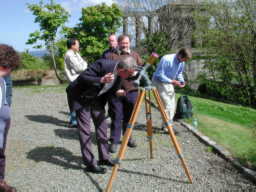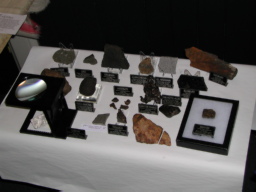SAG Meeting May 2002 Edinburgh
Glorious sunshine helped make the second 2002 meeting of SAG a memorable day out. The venue was the historic setting of the old observatory on Calton Hill, overlooking Princes St and offering unrestricted views of the Firth of Forth and the City of Edinburgh.
The meeting commenced at 1.30pm, but those who arrived early were in the right place to observe the lowering of the ball on the adjacent tower at 1pm, the signal for the one o'clock gun to be fired at the Castle. A couple of us got action shots of the event but no sound was heard from the Castle, perhaps because of prevailing wind direction.

Viewing the Sun with Edinburgh AS
telescope and H-alpha filter
The meeting was hosted by The Astronomical Society of Edinburgh, who made us all feel welcome from the outset. It was great to wander around this famous site, with its transit scope and Cooke refractor. Here, you can get a real sense of the history of science. The Edinburgh Group had set up a mini solar observatory in the form of an H-alpha filtered telescope. The other essential ingredient was a clear sky, enabling observation of both prominence and flare events. Those who had not previously seen through one of these magical filter s were suitably impressed with their first live view of a star in action.
Mark Pollock from the Renfrewshire Society chaired the meeting, welcoming some 35 attendees from around Scotland. The main speaker for the day was Dr John Davies, who entertained us with a talk in the form of a debate on the subject "Is Pluto a Planet ?" John explained that he normally gave this talk as part of a duo debate with his colleague Dr Suzie Ramsay, but on this occasion he had to wear both hats. This he did most effectively, presenting the arguments for both sides with great authority. As you might expect there was no clear answer, but the most convincing comment seemed to be that if Pluto was discovered today, it would not be classified as a planet. A vote was taken at the end of the talk, and the balance of opinion was that Pluto is not really a planet - no doubt astrologers will be able to reconcile this difficulty quite easily! Mark called for a vote of thanks for John, and the meeting then adjourned for a cup of coffee up at the main building, together with more solar observing and general chat amongst like-minded folk. This was a good opportunity to discuss views and compare technical issues relating to recent observations of Comet Ikeya-Jhang.

Part of the meteorite collection display
After about half an hour the meeting recommenced with reports from societies. Reports were received from Renfrew, Falkirk, Stirling, and Edinburgh. In particular, the Falkirk Members were congratulated on the announcement of their recent grant award. Douglas Cooper then introduced one or two items passed to him by Ken MacKay - some interesting information on distance learning was made available. Turning to members' contributions, Walter Scott presented several slide photographs taken by himself, Russell Cockman, and Malcolm Gibb, all from the Association of Falkirk Astronomers. These were of wonderful auroral displays, wide field and constellation shots, planetary and occultation, and last but not least, shots of Comet Ikeya - Jhang. Malcolm's shots were particularly interesting from the point of view that they had been taken with the extremely expensive and high tech "barn door" mount, made and powered by himself. Bill Ward then gave us some good observational scientific stuff, comparing CCD shots of the nucleus of the comet, taken as it headed out from perihelion. The camera was one that Bill had constructed from a kit. He also displayed the varying angle of the dust tail as the comet rounded the Sun, and threw in a picture he had taken of another comet which the rest of us had missed in our enthusiasm for Ikeya- Jhang.
Lorna McCalman of Edinburgh Astronomical Society showed us some photos she had taken of the recent Dance of the Planets. These beautiful colour slides had been taken from Kilchattan Bay on the Isle of Bute and depicted Jupiter, Mars, Saturn, and Venus at sunset. It was then the turn of Angus Self and Will Jay who had each brought along their interesting and valuable meteorite displays. These had been set up at the beginning of the Meeting, and had been the topic of much discussion during the tea break. Will explained how he found and recorded each item in desert areas, using GPS satellite systems to record location- truly amazing. The displays were well perused and photographed at the end of the meeting.
Some advice on observing with binoculars in preference to telescopes, as a first time set-up, was then passed on by the Edinburgh group. A pair of recently acquired 11x80's were on display.
The meeting was then drawn to a close, with Mark Pollock and Brian Kelly reminding everyone of the SAG weekend in Dundee in September - an event not to be missed, if previous years are anything to go by.
A special thanks goes to the Edinburgh Astronomical Society for hosting the meeting, and in particular to Lorna McCalman, President of the Society, for all her hard work and effort to make our day most enjoyable. Most people then adjourned to the main building for a glass of wine supplied by our hosts! The hospitality was much appreciated. Folk chatted and relaxed in the sunshine, overlooking our capital city, until the call went out for those interested in going for a meal. Fourteen of us then wandered down the hill to an excellent curry house in Leith Walk, where the buffet selection proved irresistible, particularly to the Stirling contingency.
With clear skies beckoning, the Stirling and Falkirk folk headed back up the motorway to commence an observing session near Callander. Our Edinburgh hosts are also believed to have commenced an alternative session in a nearby hostelry - and that ' s what Astronomy is all about. And what happened after that?
A fantastic Aurora Borealis, that's what, probably the best visible so far from Central Scotland this year. Commencing about midnight, shafts of light and a green curtain heralded a three hour multi-coloured display which tantalised members of the Stirling and Falkirk contingency. Pictures are available for viewing on the SAG Gallery page with more on the Falkirk site.
All in all, a memorable day, and night.